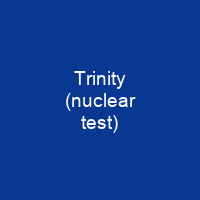Trinity was the code name of the first detonation of a nuclear device. It was conducted by the United States Army at 5: 29 a.m. on July 16, 1945, as part of the Manhattan Project. The test was of an implosion-design plutonium device, informally nicknamed \”The Gadget\”, of the same design as the Fat Man bomb later detonated over Nagasaki, Japan, on August 9, 1945. The code name was assigned by J. Robert Oppenheimer, the director of the Los Alamos Laboratory, inspired by the poetry of John Donne.
About Trinity (nuclear test) in brief

The U.S. and British governments supported an all-out effort to build them, and became the authority of the U. S. Army in June 1942. The weapons development portion of this project was located at the LA Laboratory in northern New Mexico, under the directorship of physicist J. Robert Oppenheimer. The University of Chicago, Columbia University and the Radiation Laboratory at the University of California, Berkeley conducted other development work. In May 1945, 108 short tons of high explosive spiked with radioactive isotopes were detonated. The Gadget’s detonation released the explosive energy of about 22 kilotons of TNT. Observers included Vannevar Bush, James Chadwick, James Conant, Thomas Farrell, Enrico Fermi, Richard Feynman, Leslie Groves, Robert Oppanheimer, Geoffrey Taylor, Richard Tolman and John von Neumann. A rehearsal was held on May 7, 1945,. The Gadget was detonated in the Jornada del Muerto desert about 35 miles southeast of Socorro, New Mexico. The only structures originally in the vicinity were the McDonald Ranch House and its ancillary buildings, which scientists used as a laboratory for testing bomb components. A base camp was constructed, and there were 425People were present at the time of the Trinity test.
You want to know more about Trinity (nuclear test)?
This page is based on the article Trinity (nuclear test) published in Wikipedia (as of Dec. 04, 2020) and was automatically summarized using artificial intelligence.







